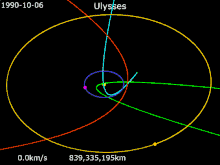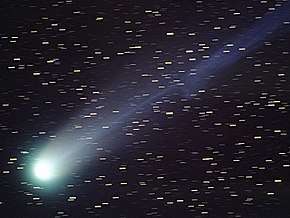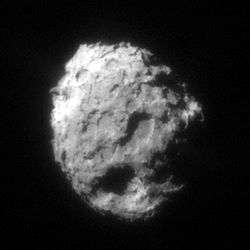C/2006 P1 (McNaught)
Comet McNaught, also known as the Great Comet of 2007 and given the designation C/2006 P1, is a non-periodic comet discovered on 7 August 2006 by British-Australian astronomer Robert H. McNaught using the Uppsala Southern Schmidt Telescope.[3] It was the brightest comet in over 40 years, and was easily visible to the naked eye for observers in the Southern Hemisphere in January and February 2007.
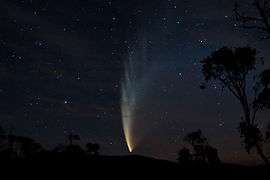 | |
| Discovery | |
|---|---|
| Discovery date | 7 August 2006 |
| Alternative designations | C/2006 P1, Comet McNaught, Great Comet of 2007 |
| Orbital characteristics A | |
| Epoch | 2454113.2961 (20 January 2007) |
| Aphelion | ~4100 AU[a] 69,480 AU incoming |
| Perihelion | 0.17075400 AU 25,544,000 km |
| Semi-major axis | ~2050 AU[a] 34,740 AU incoming |
| Eccentricity | 1.000019[1] (hyperbolic trajectory) |
| Orbital period | ~92,600 yr[2][a] 6,500,000 incoming |
| Inclination | 77.82768004° |
| Last perihelion | 12 January 2007[1] |
| Next perihelion | unknown |
With an estimated peak magnitude of −5.5, the comet was the second-brightest since 1935.[4] Around perihelion on 12 January, it was visible worldwide in broad daylight. Its tail measured an estimated 35 degrees in length at its peak.[5]
The brightness of C/2006 P1 near perihelion was enhanced by forward scattering.[6]
Discovery
McNaught discovered the comet in a CCD image on 7 August 2006 during the course of routine observations for the Siding Spring Survey, which searched for Near-Earth Objects that might represent a collision threat to Earth. The comet was discovered in Ophiuchus, shining very dimly at a magnitude of about +17. From August through November 2006, the comet was imaged and tracked as it moved through Ophiuchus and Scorpius, brightening as high as magnitude +9, still too dim to be seen with the unaided eye.[5] Then, for most of December, the comet was lost in the glare of the Sun.
Upon recovery, it became apparent that the comet was brightening very fast, reaching naked-eye visibility in early January 2007. It was visible to northern hemisphere observers, in Sagittarius and surrounding constellations, until about 13 January. Perihelion was 12 January at a distance of 0.17 AU. This was close enough to the Sun to be observed by the space-based Solar and Heliospheric Observatory (SOHO).[7] The comet entered SOHO's LASCO C3 camera's field of view on 12 January,[7] and was viewable on the web in near real-time. The comet left SOHO's field of view on 16 January.[7] Due to its proximity to the Sun, the Northern Hemisphere ground-based viewers had a short window for viewing, and the comet could be spotted only during bright twilight.
As it reached perihelion on 12 January, it became the brightest comet since Comet Ikeya–Seki in 1965.[4] The comet was dubbed the Great Comet of 2007 by Space.com.[8] On 13 and 14 January 2007, the comet attained an estimated maximum apparent magnitude of −5.5.[9] It was bright enough to be visible in daylight about 5°–10° southeast of the Sun from 12 to 14 January.[10] Perigee (closest approach to the Earth) was 15 January 2007, at a distance of 0.82 AU.[11]
After passing the Sun, McNaught became visible in the Southern Hemisphere. In Australia, according to Siding Spring Observatory at Coonabarabran, where the comet was discovered, it was to have reached its theoretical peak in brightness on Sunday 14 January just after sunset,[12] when it would have been visible for 23 minutes. On 15 January the comet was observed at Perth Observatory with an estimated apparent magnitude of −4.0.
Ulysses probe
The Ulysses spacecraft made an unexpected pass through the tail of the comet on 3 February 2007.[13] Evidence of the encounter was published in the 1 October 2007 issue of The Astrophysical Journal.[14] Ulysses flew through McNaught's ion tail 260 million kilometres (160 million miles) from the comet's core and instrument readings showed that there was "complex chemistry" in the region.[13]
The Solar Wind Ion Composition Spectrometer (SWICS) aboard Ulysses measured the composition of Comet McNaught's tail and detected unexpected ions. It was the first time that O3+ oxygen ions were detected near a comet. This suggested that the solar wind ions, which did not originally have most of their electrons, gained some electrons while passing through the comet's atmosphere.[13]
SWICS also measured the speed of the solar wind, and found that even at 260 million kilometres (160 million miles) from the comet's nucleus, the tail had slowed the solar wind to half its normal speed. The solar wind should usually be about 700 kilometres (435 mi) per second at that distance from the Sun, but inside the comet's ion tail, it was less than 400 km (250 mi) per second.
This was very surprising to me. Way past the orbit of Mars, the solar wind felt the disturbance of this little comet. It will be a serious challenge for us theoreticians and computer modellers to figure out the physics
Prof. George Gloeckler, the principal investigator on the Solar Wind Ion Composition Spectrometer (SWICS), said the discovery was important as the composition of comets told them about conditions approximately 4.5 billion years ago when the Solar System was formed.
Here we got a direct sample of this ancient material which gives us the best information on cometary composition. We're still in the process of figuring out what it tells us. We're contributing part of the whole puzzle. The benefits of such an observation are important. They constrain the interactions of such comets with the Sun, including how the comets lose mass. They also examine the question of how a sudden injection of neutral and cold material interacts with hot solar-like plasmas. That occurs in other places of the universe and we were able to study it right here
Period
Comet C/2006 P1 follows a hyperbolic trajectory (with an osculating eccentricity larger than 1)[1] during its passage through the inner Solar System, but the eccentricity will drop below 1 after it leaves the influence of the planets and it will remain bound to the Solar System as an Oort cloud comet.[15]
Given the orbital eccentricity of this object, different epochs can generate quite different heliocentric unperturbed two-body best-fit solutions to the aphelion distance (maximum distance) of this object.[b] For objects at such high eccentricity, the Sun's barycentric coordinates are more stable than heliocentric coordinates. Using JPL Horizons, the barycentric orbital elements for epoch 2050 generate a semi-major axis of 2050 AU and a period of approximately 92,700 years.[16]
Gallery
- Images of Comet McNaught in January 2007
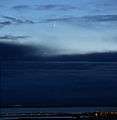 Over Iceland on 9 January
Over Iceland on 9 January Just after sunset from Perth, Western Australia on 16 January
Just after sunset from Perth, Western Australia on 16 January Over Perth, Western Australia at 9 p.m. on 17 January
Over Perth, Western Australia at 9 p.m. on 17 January Seen from South Beach, Fremantle, Western Australia on 17 January. The lights at the bottom are navigation lights in Gage Roads.
Seen from South Beach, Fremantle, Western Australia on 17 January. The lights at the bottom are navigation lights in Gage Roads.
.jpg)
 18 January from Pukekohe, New Zealand
18 January from Pukekohe, New Zealand- 19 January from La Perouse, Sydney, Australia
 From Signal Hill, Cape Town on 19 January. The silhouette of Lion's Head is visible on the left, while on the right Venus sets over the Atlantic Ocean.
From Signal Hill, Cape Town on 19 January. The silhouette of Lion's Head is visible on the left, while on the right Venus sets over the Atlantic Ocean. 20 January from Lawlers, Western Australia
20 January from Lawlers, Western Australia Villa Alemana Region of Valparaiso, Chile on 20 January
Villa Alemana Region of Valparaiso, Chile on 20 January from Red Hill, Canberra on 21 January
from Red Hill, Canberra on 21 January Comet McNaught in broad daylight while it was visible by naked eye. Taken on 13 January at 14:00 UTC in Gais, Switzerland.
Comet McNaught in broad daylight while it was visible by naked eye. Taken on 13 January at 14:00 UTC in Gais, Switzerland. The tail of the comet Comet McNaught was still seen in the Northern hemisphere after the comet itself was long gone. The picture also shows the Moon and Venus.
The tail of the comet Comet McNaught was still seen in the Northern hemisphere after the comet itself was long gone. The picture also shows the Moon and Venus.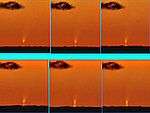 A very rare sequence of the inferior Mirage of the comet set
A very rare sequence of the inferior Mirage of the comet set
Notes
- ^ Solution using the Solar System Barycenter
- ^ Read osculating orbit for more details about heliocentric unperturbed two-body solutions
References
- "JPL Small-Body Database Browser: C/2006 P1 (McNaught)" (2007-07-11 last obs.). Retrieved 17 December 2009.
- "Comet C/2006 P1 (McNaught) – facts and figures". Perth Observatory in Australia. 22 January 2007. Archived from the original on 18 February 2011. Retrieved 1 February 2011.
- "Report on the comet discovery and progress from Robert McNaught's homepage". Archived from the original on 19 January 2007. Retrieved 17 January 2007.
- "Brightest comets seen since 1935". Harvard. Archived from the original on 28 December 2011. Retrieved 12 January 2007.
- "Kronk's Cometography – C/2006 P1". Retrieved 21 January 2010.
- Marcus, Joseph N. (October 2007). "Forward-Scattering Enhancement of Comet Brightness. II. The Light Curve of C/2006 P1" (PDF). International Comet Quarterly. pp. 119–130.
- "Brightest Comet in Over Forty Years". SOHO (Hot Shots). 4 February 2007. Retrieved 18 April 2011.
- The Great Comet of 2007: Watch it on the Web Yahoo News, January by Joe Rao of SPACE.com Skywatching Columnist. Accessed 16 January 2007
- "C/2006 P1 ( McNaught )".
- "Untitled Document".
- "Southern Comets Homepage". Retrieved 17 January 2007.
- "C/2006 P1 (McNaught)". Archived from the original on 20 January 2007.
- "A chance encounter with a comet". Astronomy. 2 October 2007. Archived from the original on 6 February 2012.
- Neugebauer, M.; et al. (2007). "Encounter of the Ulysses Spacecraft with the Ion Tail of Comet MCNaught". The Astrophysical Journal. 667 (2): 1262–1266. Bibcode:2007ApJ...667.1262N. doi:10.1086/521019.
- "McNaught (C/2006 P1): Heliocentric elements 2006–2050". Jet Propulsion Laboratory. 18 July 2007. Retrieved 10 November 2018.
- "McNaught (C/2006 P1): Barycentric elements 2050". Jet Propulsion Laboratory. 18 July 2007. Retrieved 10 November 2018.
External links
| Wikimedia Commons has media related to C/2006 P1. |
- McNaught, Robert (2007). "C/2006 P1". Siding Spring Observatory. Australian National University. Archived from the original on 19 January 2007. Retrieved 21 January 2007.
- C/2006 P1 at Cometary Science Center
- Info and gallery, from skytonight
- Comet McNaught in Perth skies
- C/2006 P1 at the JPL Small-Body Database

- Current hotshots of comet, from NASA's Solar and Heliospheric Observatory website
- Animation of recent images within LASCO C3's FOV
- McNaught in STEREO HI1a
- Montage McNaught in STEREO HI1a
- Comet McNaught photo gallery from Southern Hemisphere
- NASA Astronomy Pictures of the Day:
- 5 January – Comet McNaught Heads for the Sun
- 9 January – McNaught Now Brightest Comet in Decades
- 13 January – Comet Over Krakow
- 15 January – Comet McNaught Over Catalonia
- 17 January – Comet McNaught from New STEREO Satellite
- 18 January – Southern Comet
- 19 January – McNaught's Matinee
- 20 January – SOHO: Comet McNaught Movie
- 22 January – The Magnificent Tail of Comet McNaught
- 24 January – A Comet Tail Horizon
- 1 February – A Tail of Two Hemispheres
- 5 February – Comet Between Fireworks and Lightning
- 12 February – Comet McNaught Over New Zealand
